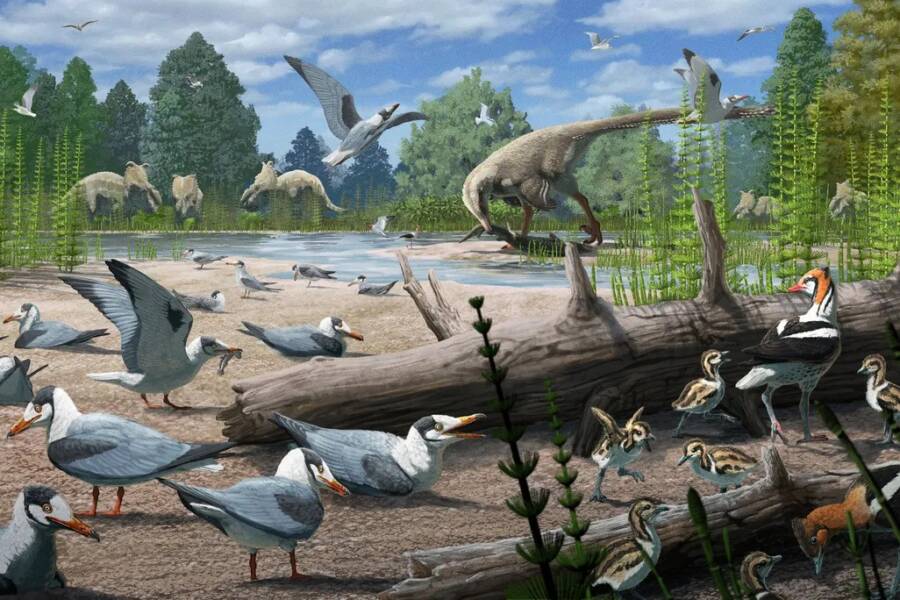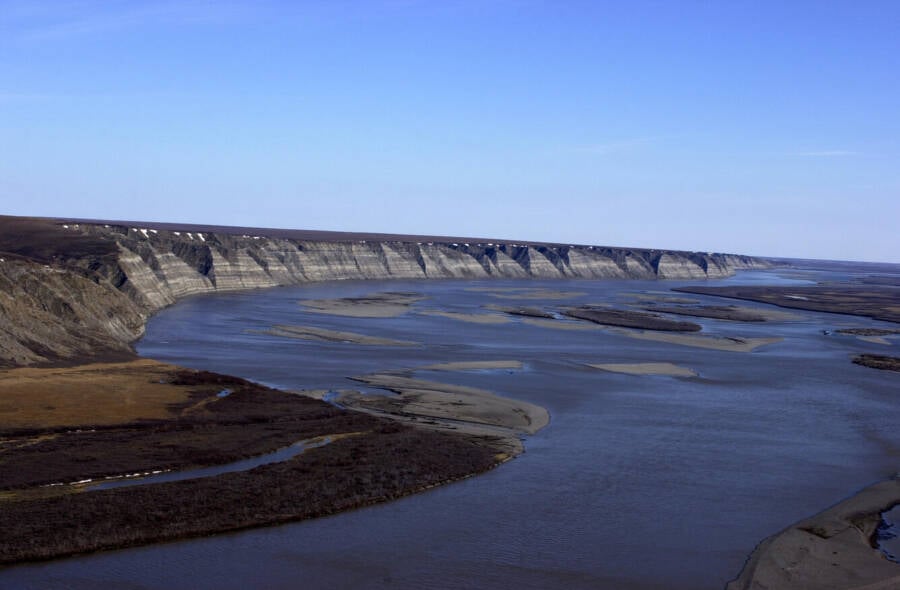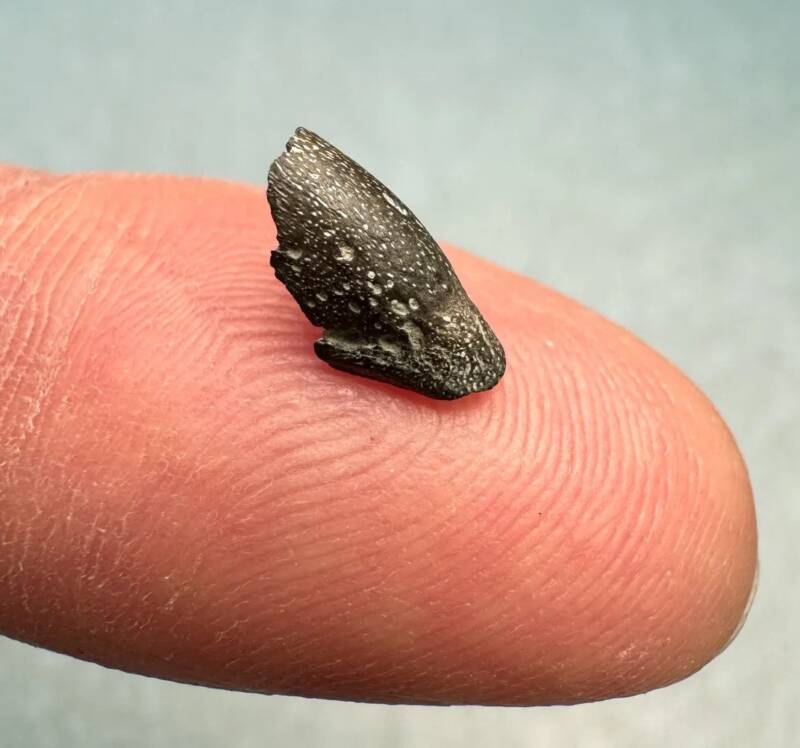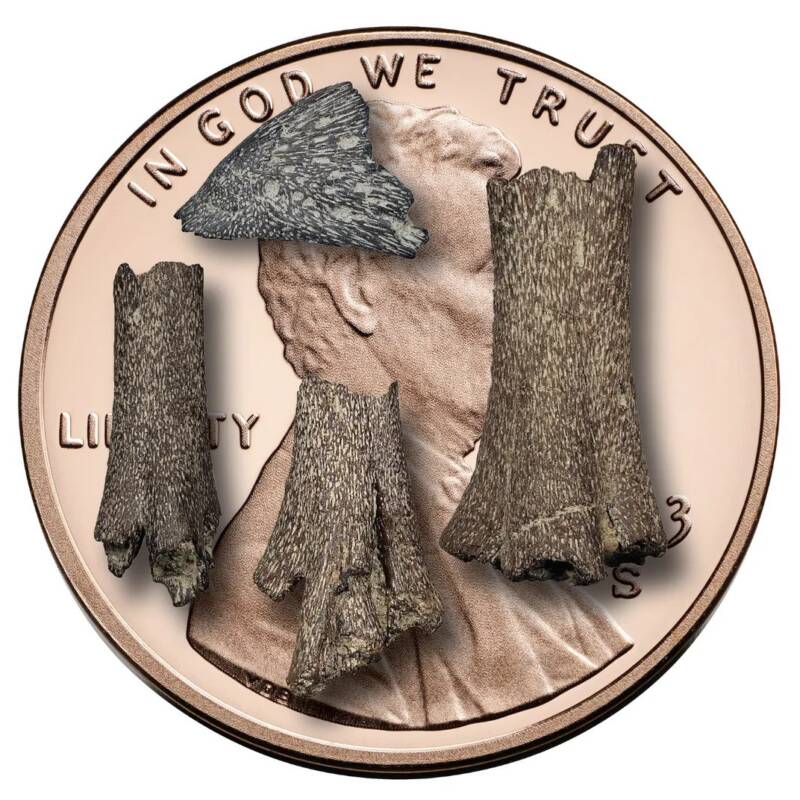The discovery pushes back the record of birds breeding in polar regions around 30 million years.

Gabriel UguetoA depiction of birds living alongside dinosaurs.
Some 73 million years ago, dinosaurs roamed across present-day Alaska. But they weren’t alone. A recent study has confirmed that birds lived and nested alongside the dinosaurs, proving that early avian species were capable of breeding even in polar conditions.
This study has not only offered new insight into the evolution of birds, which have existed for about 150 million years. It’s also “put Alaska on the map” as a place to find prehistoric avian fossils.
The 73-Million-Year-Old Bird Fossils In Alaska

U.S. Geological SurveyThe Prince Creek Formation in Alaska, where the bird fossils were discovered.
According to a new study published in Science, birds have been nesting in the Arctic for far longer than previously known. Though places like Alaska are rife with birds and their young today, this latest research suggests that birds have been nesting in polar regions for at least 73 million years, which means that they raised their young alongside dinosaurs during the Cretaceous period.
“Birds have existed for 150 million years,” study lead author Lauren Wilson, a doctoral student at Princeton University who earned her master’s degree at the University of Alaska Fairbanks, said in a statement about the discovery. “For half of the time they have existed, they have been nesting in the Arctic.”
Wilson and her team made their discovery by scouring Alaska’s Prince Creek Formation, an area known for dinosaur fossils. They recovered dozens of fossilized bones and teeth and were able to identify multiple types of birds: hesperornithes, extinct loon-like birds; ichthyornithes, extinct gull-like birds; and several species similar to modern-day ducks and geese.
Significantly, they also uncovered baby bird bones — which are porous, fragile, and rarely found in the fossil record — proving that these birds were raising their young in Arctic environments 73 million years ago.

Pat DruckenmillerThe tiny, fossilized tip of a hatchling’s beak.
“This pushes back the record of birds breeding in the polar regions by 25 to 30 million years,” Patrick Druckenmiller, one of the study’s authors and the director of the University of Alaska Museum of the North, remarked.
Indeed, the discovery demonstrates that birds were not only living in the Arctic alongside dinosaurs 73 million years ago, but that they had evolved to the point where they could raise their young in a frigid environment.
“Modern Arctic birds are incredibly important members of their ecosystems,” Wilson told All That’s Interesting in an email. “They breed in Arctic environments to take advantage of continuous summer daylight and all the abundant food resources that are a product of that prolonged sunlight. In order to benefit from these summers, they either have to overwinter, which requires adaptations to endure polar winters, or migrate, which requires adaptations to navigate and fly incredibly long distances. Since both of these strategies are so challenging, it was an incredible surprise for me when we found that this is not a strategy restricted to only modern birds, but one that has been an important part of bird ecology for least 73 million years!”
New Insights On Bird Evolution In The Arctic
The avian fossils revealed by the study are significant for several different reasons. For one, they’ve revealed that birds thrived in the Arctic for far longer than previously known. (During the Cretaceous period, the Prince Creek Formation would have been roughly 600 miles closer to the North Pole than it is today.) Before the study, the earliest known evidence of birds reproducing in polar regions was from about 47 million years ago, millions of years after an asteroid hit the planet and killed 75 percent of the animals on Earth.
For another, it’s revealed that Alaska is rich with prehistoric bird fossils.
“Finding bird bones from the Cretaceous is already a very rare thing,” Wilson noted. “To find baby bird bones is almost unheard of. That is why these fossils are significant.”

Pat DruckenmillerMany of the bird fossils found in Alaska are very small, as demonstrated by this comparison with an American penny.
Druckenmiller added: “We put Alaska on the map for fossil birds. It wasn’t on anyone’s radar… We are now one of the best places in the nation for bird fossils from the age of the dinosaurs. In terms of information content, these little bones and teeth are fascinating and provide an incredible depth of understanding of the animals of this time.”
The researchers are still hoping to discover if some of the bones they found belong to neornithes, a group that includes all modern birds. Tantalizingly, some bones have skeletal features that match neornithes and have no “true teeth,” just like modern-day birds. If they are neornithes, they would be the oldest such fossils ever found (so far, the oldest known examples are 69 million years old), but researchers would need to find a “partial or full skeleton” to know if they found neornithes remains for certain.
“We will continue to try to learn as much about our fossils as possible, and will especially re-evaluate in light of new discoveries, both from the Prince Creek and from other Late Cretaceous formations,” Wilson told All That’s Interesting. “In order to ever know for sure if a neornithine lived in the Prince Creek Formation ecosystem, we need to find a more complete specimen, or at least a few bones that we feel confident came from the same individual. In order to do this, we have to keep getting out there to do more field work!”
Ultimately, the discovery of the 73 million-year-old bird bones in Alaska tells a remarkable story about the history of birds in the region. In the time of the dinosaurs, they surprisingly behaved just as they do now.
“The Arctic is considered the nursery for modern birds,” Druckenmiller remarked. “It’s kind of cool when you go to Creamer’s Field [a Fairbanks-area stopover for migrating geese, ducks and cranes], to know that they have been doing this for 73 million years.”
After reading about the discovery of 73-million-year-old bird fossils in Alaska, learn about some of the scariest bird species in the world. Or, discover the story of the Terror Bird, the fearsome prehistoric predator.





